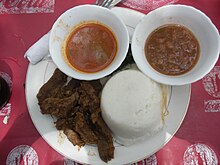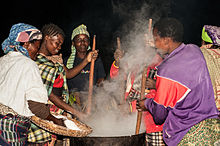Ugali
Ugali ([ uˈgaːli ]) is the name used in the East African language Swahili for a cereal porridge made from corn flour that is cooked to a relatively firm consistency. The dish is widespread in other parts of Africa as well; Depending on the language and region, for example in South Africa and Namibia it is called mielie pap or pap or in Lesotho papa , in Zimbabwe sadza , in Malawi and Zambia nsima , in Uganda posho , in Congo nfundi and in Mozambique xima or upswa .
History and dissemination
The starchy parts of various crops form the basis of their diet for most people of arable peoples around the world. In Africa, these are largely traditionally prepared in the form of porridge , which has long been a predominant form of food in Europe. Various types of millet were cultivated and cultivated in Africa early on. They were the first to provide the basis for what is now known as Ugali and is the most widely consumed in East Africa - in Tanzania , Kenya and Uganda . In addition, depending on the cultivation conditions and trade options, there are also rice , plantains (both plants originating from Asia), local yams , potatoes (imported from America via Europe) and occasional baked goods made from wheat or rye (especially in cities); furthermore, sweet potatoes (also from Asia) are sometimes eaten with morning and evening meals.
The corn plant was introduced to Africa by Europeans during the colonial period. She is originally from America. In the countries and parts of eastern and southern Africa where it thrives, it has pushed back all other crops over the course of the 20th century. Ugali is now mainly made from corn flour, only rarely from sorghum or millet .
Ugali is instead made locally from cassava or, less often since the 20th century, from wheat (in hot or high-altitude growing areas).
One speaks of Ugali only when the starchy parts of the plant ( grain seeds or tubers ) are finely chopped or mashed to a consistency of flour, grist , semolina or the like and then boiled to a pulp.
In West Africa and Central Africa , the related dishes Fufu (after the French spelling Foufou ), Akple (in the Volta region) and Tô (in Benin ) are known. Ugali is so ubiquitous, especially in Tanzania in many parts of the country, outside of rice-growing areas, that the word is sometimes used as a synonym for "food". In cities, too, ugali is one of the usual dishes in restaurants run and frequented by Africans, or in some cases it is the only offer at all.
The preparation
For the classic preparation, corn kernels are crushed in a mortar with salt and a little water and then boiled with the addition of water. A more modern method is similar to making European polenta . To do this, some cornmeal is stirred into water and boiled on the fireplace or stove. Then gradually add more cornmeal while stirring. With frequent stirring and, if necessary, with the addition of a little water, the porridge is cooked for about half an hour (or less) until the mass becomes more and more viscous and clumps into a ball. It is then no longer a flowable porridge, but rather resembles a meal in consistency that would be somewhere between a “solid” mashed potato and dumplings in terms of firmness.
For Europeans, Ugali is translated into English by the locals as stiff porridge, i.e. as stiff cereal groats based on the popular dish made from oatmeal in Great Britain, porridge . In Swahili, on the other hand, the name Uji ( j spoken as in English, emphasized on the long U ) is common for a porridge dish that can still flow .
The meal


The unseasoned ugali is served with a wide variety of side dishes - depending on what is available to the people: sauces , stews or ragouts , on the coast of the sea or large lakes often with fish , rarely with meat (in East Africa mostly chicken or goat ) , almost always with vegetables , often legumes . A sauce can e.g. B. made of native spinach-like leafy vegetables or pumpkin leaves , onions , vegetable oil and ground peanuts . Regionally, Ugali is also served as a meal - alone - with (strongly sour) sour milk .
Traditionally, meals are taken with the hands. For this reason, guests are given washing water in a bowl, soap and a towel at the table. The maize porridge is consumed by shaping bite-sized pieces with the fingers of the right hand, pressing a “pit-like” recess with the thumb if necessary and then using this portion to pick up the side dish (s) or dipping it into the sauce and bringing it to the mouth . Cutlery is usually only used by European guests or in restaurants in larger cities.
According to African understanding and linguistic usage, Ugali is by no means a side dish even with a lavish range of dishes (for example to a main course such as meat or fish), but rather the other way around as the dish (Swahili: chakula / ch spoken as in English, emphasized on the long u ) to which side dishes (Swahili: mboga , pronounced m-bo-ga with an emphasis on the long o , i.e. literally "vegetables") are served. In restaurants you also order Ugali nyama (pronounced "n-ya-ma", stressed on the first - short - a ) or Ugali maharagwe (stressed on the penultimate syllable, w as in English) for a serving of "Ugali (with) Meat "or" Ugali (with) beans ".
Mielie Pap in Namibia

Mielie Pap (also Mealie-Pap ) is made from Mielie flour ( corn flour ) and water, milk or Omaere and is mostly eaten by hand. It is the traditional staple food in much of Namibia with the exception of the north, where pap is made from mahangu ( pearl millet ). Mielie Pap is prepared in the morning and serves as the main component of breakfast in the initially liquid form, is eaten until midday due to the dehydration and finally in the evening with a very solid consistency. Meat is also eaten in the evening, if available.
The Herero mostly use cow's milk for their preparation, while the Damara mostly use goat's milk . In rural areas, the maize porridge is also enriched with sugar, honey or butter. Other variations of the Mielie Pap are Maheei and Maxau . In recent years, home-baked or bought bread has become a popular alternative to Mielie Pap.
literature
- Handbook of Agriculture and Food in the Developing World . Edited by Peter von Blanckenburg, Volume 4 - Sigmund Rehm : Special Plant Production in the Tropics and Subtropics . 2nd revised edition. E. Ulmer, Stuttgart 1989, ISBN 978-3-8001-3072-6 .
- Alan Davidson : The Oxford Companion to Food . Oxford University Press, Oxford 1999 (892 pages), ISBN 0-19-280681-5 ; Article East Africa .
Web links
Individual evidence
- ↑ James McCann: Stirring the Pot: A History of African Cuisine . Ohio University Press 2009, p. 137.
- ^ "Until the Middle Ages (and beyond) porridge was the most important food of the Germanic peoples, similar to the other agrarian peoples of Europe. [...] For the rural population of Scandinavia and Central Europe, porridge dishes predominated until the 18th century [...], namely in the morning and evening meals. ” Reallexikon der Germanischen Altertumskunde . Vol. 3. De Gruyter, Berlin and New York 1978, Article Brei , p. 429.
- ↑ James McCann: Stirring the Pot: A History of African Cuisine . Ohio University Press 2009, p. 139.
- ↑ See The Oxford Companion to Food , p. 265 f.


